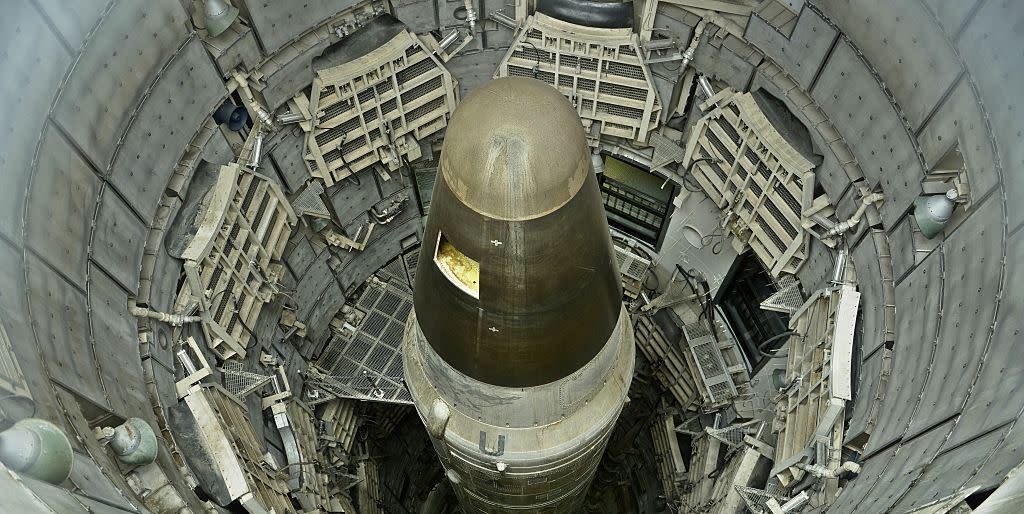America Never Had a Chernobyl. But It Came Close.

- Oops!Something went wrong.Please try again later.
HBO's Chernobyl is over, but if you've seen the series, you'll remember it for a long time.
Coming on the heels of the mega-hyped Game of Thrones series finale, the five-part miniseries—created and written by Craig Mazin, and directed by Johan Renck—quickly overtook the fantasy story with its astonishing performances and commitment to its immersion in a world that Americans never really understood.
The focus in the discussion around Chernobyl lies where the miniseries has gone: nuclear reactors meant for peaceful energy. The safety of nuclear plants is of upmost importance, but that's not the only place nuclear energy is located. According to the Bulletin of Atomic Scientists, the Department of Defense maintains an estimated stockpile of approximately 4,000 warheads. Mishaps with these weapons of mass destruction are referred to as "Broken Arrow" accidents.
The United States has officially had approximately 32 of these incidents, often involving the transport of weapons from one location to another. None of these incidents caused a major disaster, let alone a Chernobyl-like event. Two nuclear weapons were dropped on Goldsboro North Carolina in 1961 and are now commemorated with an historical marker. But there's no such memorial for the 1980 accident in which a Titan II missile carrying a thermonuclear reactor exploded near Damascus, Arkansas.
Chernobyl offers a new chance to examine these Broken Arrows. Fortunately, both the stories of Goldsboro, the Damascus Incident, and other Broken Arrows have already been documented in the film Command and Control, directed by Robert Kenner and based on a book by Eric Schlosser.
Available on PBS, Netflix, and other streaming services, the documentary shows that the story of lies and of nuclear mismanagement is not limited to Soviet borders.
On September 18, 1980, routine maintenance on an Titan II went awry. A Propellant Transfer System (PTS) team was working on the missile under the authority of the Air Force. A ratchet was used instead of a torque wrench, and that was all it took for a socket from the missile's oxidizer tank to fall 80 feet down, where a freak bump allowed it to puncture the missile's first-stage fuel tank.
Efforts to stabilize the missile failed, and late into the night, it exploded. Two men sent in to vent the gas were presumed dead. One of them, Senior Airman David Livingston, died 12 hours later. The nuclear warhead was later found in a field.
There are many differences between Damascus and Chernobyl, of course. Honesty was maintained within the chain of command, although the man who dropped the socket had trouble articulating the truth of the situation for half an hour afterward. And while safety protocols couldn't keep the 7-story missile from exploding, they did keep the warhead in check.
But when it comes to nuclear incidents, Command and Control makes it clear that the U.S. shares more with the scientists of Chernobyl than many feel comfortable to admit.
There may not be a deeply embedded culture of lying stateside, but the U.S. was as willing to cover up the truth of Damascus, as well as thousands of other nuclear accidents, for decades. And when it came down to the final decision making in Damascus, the documentary paints a picture of an out-of-touch Strategic Air Command that issued commands without any understanding of the situation on the ground—decisions that resulted in Livingston's death.
Mazin has made it clear that his Chernobyl is not primarily focused on nuclear power. It's a complex subject, as Valery Legasov, played masterfully by Jared Harris, makes clear in the final episode. But perhaps the greatest similarity between Damascus and Chernobyl was the confident belief that nuclear power could be safely managed at all.
Explaining how nuclear power works in a Soviet court, Legasov describes a dance that can generate tremendous energy. But as Adam Higginbottom shows in Midnight in Chernobyl, it's a dance that people have been trying to get right for many years.
The Soviet system might have set up the scientists at V.I. Lenin Nuclear Power Plant for failure. But even with the best dancers in the world, there's eventually a missed step.
You Might Also Like

